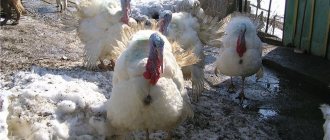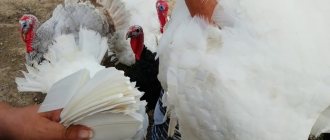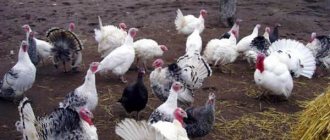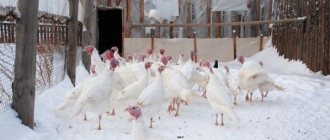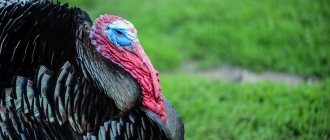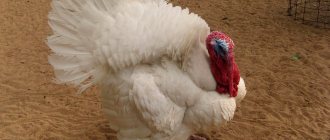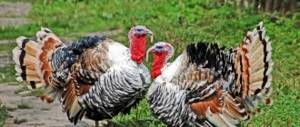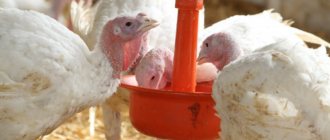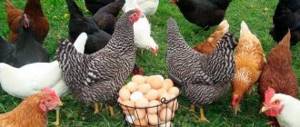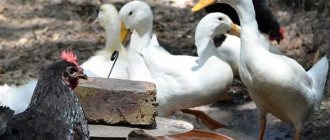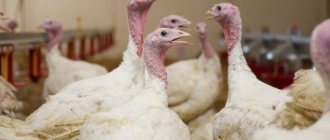The sex of turkeys can be distinguished by external characteristics already at the age of 8-10 weeks. Turkeys at this age are larger, heavier, with thicker tarsus. Their head is unfeathered, covered only with skin, and the nasal process is larger and more elastic, unlike females. The turkey is smaller, its head is covered with downy feathers, the nasal process is small and pressed. In adult animals this difference is more pronounced. The turkey has a “tassel” on its chest and spurs on its tarsus.
Fleshy warty growths of turkeys, filled with spongy bodies and extending far into the chest area. When excited or before mating, turkeys are characterized by special behavior. The spongy bodies of the “corals” and nasal growths fill with blood and increase in volume. The turkey ruffles its feathers, the tail feathers rise perpendicular to the back and open up in a chic fan. The turkey also stretches the flight feathers of its wings and “draws” the ground with their tips, moving in a circle and making bubbling sounds.
Which turkey is best for breeding?
In purebred breeding, a turkey must comply in size, body shape, color of plumage, eyes, beak and tarsus with the standard requirements for the corresponding breed. The most suitable are turkeys that were highly appreciated by the commission and specialists at an exhibition or auction. Turkeys must have good fertilizing ability, be active during mating and have a lively temperament. They should have lively, clean eyes, a smooth head without any tumors and without necrotic spots, clean, dry, regular tarsus with evenly spaced toes.
What should a breeding turkey look like?
In purebred breeding, a turkey must have the typical characteristics of its breed. The purity of the breed is 100% determined at exhibitions or auctions. The turkey must be healthy, of a calm temperament, with the premise of laying fertilized eggs of the appropriate size that are suitable for incubation.
How many turkeys should there be per turkey?
A guarantee of good egg fertilization is the allocation of such a number of turkeys per turkey, with which he has time to mate and fertilize them. In small breeds it will be enough to have 8-9 turkeys per 1 turkey, in medium breeds - 6-8 turkeys. In large breeds, artificial insemination is used, so keeping one turkey for 20-30 turkeys is enough.
Rules for fertilizing turkeys
The process of egg fertilization can be natural or artificial. On an industrial scale, artificial insemination is widely practiced to obtain eggs for incubation. In home keeping, this method is practiced less often, as it requires additional skills and devices.
- At what age is a male able to fertilize a female?
- How many times must a turkey mate to produce a fertilized egg?
- How can you tell if an egg is fertilized or not?
Turkey 8 months
When kept at home, a turkey is able to fertilize a female at the age of 8 - 9 months. The bearing period is in spring or autumn. The number of eggs laid varies from 10 to 30 pieces. After the turkey finishes laying eggs, additional eggs can be placed in her nest. How many additional eggs there will be depends on the number of eggs in the nest, usually this can vary from 12 to 17 pieces.
On an industrial scale, turkey poults are raised throughout the year, so turkeys begin laying eggs at 28-34 weeks, regardless of the time of year. The intensity of oviposition increases rapidly, and by the 8th week it begins to gradually decrease.
If this is a purebred breeding, then the turkey must meet the following criteria:
- Magnitude.
- Body shape,
- Color of plumage, eyes, beak and tarsus.
The most valuable males are those that participated in the exhibition and were highly appreciated. In addition to these qualities, a turkey must have the following properties:
- good fertilizing ability,
- have increased activity during mating and a lively temperament.
External data must meet the following requirements:
- living clean eyes,
- smooth head without tumor formations and necrotic spots,
- clean, dry and straight shanks with evenly spaced toes.
For purebred breeding, it is tedious to select turkeys that meet the following qualities:
- body shape and size,
- body mass,
- plumage color,
- color of eyes and tarsus.
How long do turkeys grow?
Turkeys are a rather gentle and capricious bird. During the entire period of development, they can suffer from all sorts of diseases, and also stop growing due to poor diet. The question of how long turkeys grow before slaughter can be answered in different ways. The time for a bird to grow up and gain slaughter weight depends on the breed, diet and characteristics of bird care.
To achieve intensive growth of turkey poults, you need to monitor the cleanliness of the room, regularly clean the feeders and drinkers from food debris, set a favorable temperature regime, and avoid drafts. The ideal option would be to include complete feed in the birds’ diet, which will ensure a good daily gain in live weight. In the absence of special food, in the first days of life, the chicks are fed cottage cheese, crushed grains of wheat and corn, and boiled eggs. About a week after birth, chopped greens are added to the food, and milk or yogurt is added to wet mash based on concentrates. At first, turkeys are fed frequently, up to 6 times a day, adjusting the dose of food.
If all conditions are met, broiler turkey breeds are ready for slaughter after only 4 months of keeping. According to experienced farmers, further fattening of poultry is ineffective, since the birds begin to consume large amounts of food. How long turkeys grow depends on the owner; you can slaughter a bird at 4 months of age when it reaches a weight of 7-8 kilograms or a year later, when the weight of adults is 20-25 kilograms. When raising poultry, you should use special tables that describe the daily feed consumption for an individual turkey. If a complete balanced feed is used as the main food, then the following amount of food will be used to achieve slaughter weight for birds:
- to raise young animals up to 8 months of age, 52 kilograms of feed will be needed per head;
- for fattening a female up to 4 months of age - 16 kilograms of feed;
- a male placed for fattening eats 30-32 kilograms of feed.
Buying special feed is not always economically profitable, especially if you can replace it. From homemade food, turkey poults are given crushed grain of various cereals, cereals, dairy products, yeast, and chopped greens. Also crushed chalk and limestone and small pebbles are added to the feeders.
Sources: sam-stroy.info, www.agro-biz.ru, www.timeboil.ru, klyv.ru, fermer.rusff.ru, fermerstyle.ru, olgaview.blogspot.ru
Chervonopoyasa pig breed
The Breitov breed of pigs was obtained in the Yaroslavl region by crossing local pigs with Danish Landrace, Large White, Medium White and.
Keeping nutria outdoors in winter
If you want to receive a lot of eggs from laying hens in the winter, you need to choose the right diet that will replenish the body with all of them.
Buy vaccinations for rabbits
If you decide to start rabbit farming and want to purchase breeding rabbits for this, you must remember what the animals need.
How to make a drinking bowl for rabbits
The most basic way to make a drinking bowl for rabbits yourself is to take some kind of plastic bottle or canister and attach it to.
How to properly butcher a pig
Hello, in this article I will tell you how to properly slaughter a pig, as well as how to properly cut a pig carcass. In 12-13 hours.
Rabbit toilet
You can buy a corner litter box or a cat litter box as a toilet. The cat litter box is more convenient because some rabbits like to throw litter around, but...
Formation of the parent herd
To obtain hatching eggs, it is necessary to create a parent flock. Its numbers vary. The number of females in a herd depends on the breed. For heavy breeds, there are 6 females per 1 turkey. If the individuals are of average weight, then the number of females is increased to 10 heads. Light weight birds are characterized by good activity and ability to fertilize. For 1 male there can be up to 15 females:
- For the parent stock, individuals with excellent productivity indicators and high exterior characteristics are selected. Birds should not have any flaws. All parameters must comply with generally accepted standards within the breed;
- pay attention to the physique, plumage, shape of the neck, head, limbs;
- individuals who previously suffered from any infectious diseases are discarded;
- choose birds with a calm temperament. Turkeys are distinguished by their emotionality. Leadership qualities are genetically embedded in them. They are always ready to fight with other males in the herd. Aggressive turkeys are not accepted into the parent flock.
Crossbreeding is usually done within the same breed, but the palace breeders are experimenting. To obtain the desired color and a certain indicator of productivity in a bird, birds of various breeds are used for breeding flocks. Black Tikhoretsk turkeys have dark plumage. They have well-developed egg production, but do not reach the weight of large individuals.
More on the topic: How to build an enclosure for turkeys?
On the contrary, the white Moscow line has good meat qualities. Podvorets often cross both breeds. The result is individuals with white plumage with black speckles. The turkeys look beautiful. They are able to rapidly gain body weight.
When forming a parent flock, it is necessary to pay attention to family ties between birds. Crossbreeding between relatives is not allowed. The embryo in the eggs will develop with pathologies. If the bird family is not properly assembled, deformities are observed in the offspring: the chicks are discarded.
At what age do male turkeys impregnate turkeys?
At home, turkeys begin to mate in the eighth or ninth month of their life. The mating process occurs in spring or autumn. The eggs laid during this period number a dozen or thirty copies.
Tip: When the females have laid their eggs, several additional eggs are placed in their nests, so that there are from 12 to 17 eggs in one nest.
Industrial farms raise chicks year-round. Egg laying of turkeys begins at 28 or 34 weeks; the time of year in this case does not matter. The egg laying grows rapidly until the eighth week, later the process slows down and declines.
What to feed turkey poults in the first days of life.
Caring for and feeding turkey poults in the first days of life at home requires increased attention to feed. As mentioned above, immediately after hatching, the chicks are given only low-fat cottage cheese with a boiled egg. In the future, the diet is made more varied.
Wet mash, which can be given to turkey poults in the first days of life, may include millet, wheat mud and curdled milk. You can put oatmeal in separate containers. Already from the fourth day they begin to prepare porridge with milk or whey. Consumption of dairy products will help the chicks develop their skeletons faster.
If the farm uses intensive growing technology, the diet from the first days is based on industrially produced feed for turkeys.
Selecting turkeys for mating
When breeding a pure breed, a turkey is required to: size, body shape, color of feathers, eyes, beak and tarsus. Valuable males usually take part in exhibitions and receive high marks. The turkey must have excellent fertilizing ability. A correct male with good data actively mates and is characterized by a lively temperament.
According to external data, the best are considered to be male turkeys with lively, clear eyes, a smooth head, on which there is no tumor or necrotic spotting. Each shank must be properly shaped, clean and dry, and the fingers must be evenly spaced.
How to choose turkeys for mating?
First of all, the male is selected based on his size, and you need to pay attention to the flaws in the body. Turkeys with healthy eyes are better suited for mating; there should be no tumors or spots on the head. It is advisable that the shanks be dry.
Naturally, the temperament must be high. The best option is neat, medium-sized males. The age of the turkey must also be taken into account. Do not allow adults to mate more than once. Three matings should take place within a week before oviposition.
About
Turkey family composition
To breed a small breed, one young gobbler needs to roam with 8 or 9 does. To breed medium-sized birds, you need to provide 8 turkeys for one male. For large-bred birds, artificial insemination is used, then for a flock of 20 or 30 turkeys, one male will be enough.
Tip: The older a turkey gets, the fewer females he needs to mate.
An adult turkey only needs to mate once to fertilize a female. But before egg laying begins, turkeys are required to mate approximately 3 times in seven days. The third or fifth zwj laid can often be considered fertilized. The following specimens, as a rule, are not suitable for incubation, since fertility decreases in the process.
Refusal of turkeys from females, reasons
It happens that the male does not trample the turkey. There can be many factors influencing mating refusal. For example, a livestock may be infected with an infectious disease, or a particular male may become ill. You need to be wary of not only the reluctance of turkeys to mate, but also mortality in the herd; you may need the help of a veterinarian.
One of the reasons that male birds do not begin to mate with female birds may be an imbalance in nutrition. For productivity, it is important that the turkey menu is selected correctly and fully, and that balance is maintained.
Advice: The best sires will be medium-weight males who can trample females without injury. A large male can harm the turkey.
Breeds may also not mix well. Family ties also have a negative impact on the offspring, when an individual with deformity may appear, and survival rate will be poor.
Sometimes the turkeys themselves are aggressive, which is influenced by various discomforts associated with insufficient lighting, poor ventilation or lack thereof, poor-quality feeding or lack of nutrients, and excessive density of the herd.
In a turkey flock there is usually a dominant male. He may prevent a rival from mating with a particular female. The strongest always has the right to mate.
If birds are kept in violation of the rules and do not comply with conditions, this can also negatively affect the reproduction of offspring by turkeys.
How does mating happen?
To determine how turkeys mate, it is necessary to consider the structure of the birds' genital organs. The genital organs of turkeys consist of testes, epididymis, vas deferens and a copulatory organ from which seminal fluid emerges. Sperm mature in the testes. This is a paired organ. During puberty it increases in size. In turkeys of heavy breeds, the testes can weigh 70 g.
The bird's appendages are not developed. Sperm move along the vas deferens, bypassing them. The vas deferens is a thin, winding tube. When the testes begin to work hard, the vas deferens expands and its walls become thicker. Sperm enter the copulatory organ. It has access to the cloaca. In turkeys it is represented by a slight thickening, similar to a small onion. Through it, seminal fluid flows to the female.
The reproductive organs in females are represented by the ovary, which contains the eggs: they are attached to the walls of the ovary with a stalk. Blood vessels pass through it, feeding the cell. When the cell matures, it detaches from the wall of the ovary and passes into the oviduct. There is a funnel on the oviduct. Its muscular walls capture seminal fluid and transport it to the egg. Fertilization occurs.
The cell then passes through the oviduct. The white forms around the yolk. In the isthmus of the uterus, the formation of outer membranes occurs. In the uterus, the membranes become hard. In this section the egg is finally formed. It goes out through the oviduct: the oviduct has an outlet into the cloaca.
Turkeys Mating
Mating is a complex process for a turkey. This is especially true for males of heavy breeds. They have a lot of weight and voluminous plumage. The male climbs onto the female's back. Tries to bring its copulatory organ to the turkey's cloaca. People say that a turkey tramples a turkey. Mating occurs.
Igor Nikolaev
auto RU
The female sits patiently, spread out on the ground, and waits for the process to complete. The next egg the hen lays will be fertilized. One mating will be enough for the turkey to lay up to 10 eggs. Only the first 6-8 eggs are taken for incubation. The rest, as a rule, have pathologies.
More on the topic: Why don’t turkeys lay eggs?
Housekeepers often discuss on forums how to mate individuals. Not all males know how to trample females. Turkeys are mounted on turkeys, but the males have no desire or interest in the female. This does not mean that the turkey has any deviations. It’s just that, as poultry farmers say, not all males are able to approach females correctly.
It is recommended to keep young and more experienced turkeys in the same enclosure so that the turkeys pass on experience to the younger generation. Turkeys are released into this enclosure to mate with males.
Some males may not like the female. If a laying hen has bald patches on her plumage, growths on her skin, or on her head, then turkeys drive away such birds. They don't like them. To make males more active, it is recommended to keep them separately from laying hens. The male is released only during the period when it is necessary to obtain hatching eggs.
Checking eggs for fertility
Eggs are often checked using an ovoscope. The device consists of a cylindrical body with illumination at the bottom. To ensure that the eggs are rejected and do not end up in the nests of laying hens or the incubator, you need to pay attention to whether the egg is “marbled” in color or not, whether there are scratches, stripes, or cracks on the shell.
In a good egg, the location of the air chamber corresponds to the side of the blunt end and is small in size. There cannot be a single extra inclusion in the cavities of products for incubation. Whether an egg is fertilized or not, even through an ovoscope, can be seen only when the object has lain in an incubator or under a hen for 5 days.
An unfertilized testicle is transparent; you can see a slightly translucent yolk and an airy cavity.
A fertilized testicle is characterized by the presence inside a small point, sometimes in the form of a grain, with blood vessels near it. When the presence of an embryo is visible, but blood vessels are absent, this most likely indicates that the embryo has died.
The last check takes place a couple of days before the baby is born. This stage corresponds to complete shade of the egg, but the area with the air chamber is lighter. The death of the embryo is indicated by the dark middle of the testicle with light areas on each side of the object.
